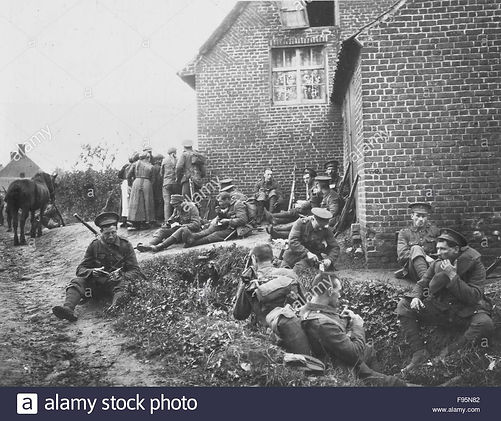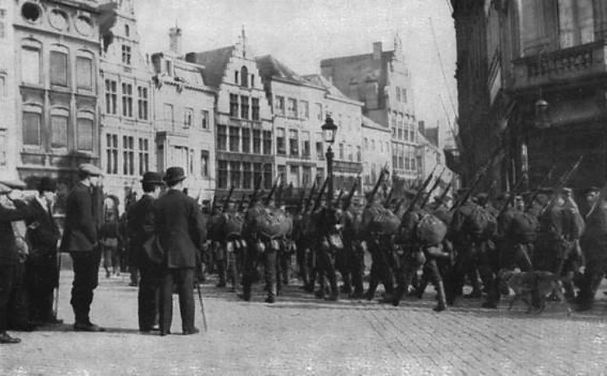First Battle of Ypers
On October 19, 1914, near the Belgian city of Ypres, Allied and German forces begin the first of what would be three battles to control the city and its advantageous positions on the north coast of Belgium during the First World War.
After the German advance through Belgium and eastern France was curtailed by a decisive Allied victory in the Battle of the Marne in late September 1914, the so-called “Race to the Sea” began, as each army attempted to outflank the other on their way northwards, hastily constructing trench fortifications as they went. The race ended in mid-October at Ypres, the ancient Flemish city with its fortifications guarding the ports of the English Channel and access to the North Sea beyond.

British troops in Belgium
After the Germans captured the Belgian city of Antwerp early in October, Antwerp’s remaining Belgian forces along with troops of the British Expeditionary Force (BEF), commanded by Sir John French, withdrew to Ypres, arriving at the city between October 8 and 19 to reinforce the Belgian and French defenses there. Meanwhile, the Germans prepared to launch the first phase of an offensive aimed at breaking the Allied lines and capturing Ypres and other channel ports, thus controlling the outlets to the North Sea.
On October 19, a protracted period of fierce combat began, as the Germans opened their Flanders offensive and the Allies steadfastly resisted, while seeking their own chances to go on the attack wherever possible. Fighting continued, with heavy losses on both sides, until November 22, when the arrival of winter weather forced the battle to a halt. The area between the positions established by both sides during this period—from Ypres on the British side to Menin and Roulers on the German side—became known as the Ypres Salient, a region that over the course of the next several years would see some of the war’s bitterest and most brutal struggles.


German troops in Antwerp
Second Battle of Ypers
On this day in 1915, German forces shock Allied soldiers along the Western Front by firing more than 150 tons of lethal chlorine gas against two French colonial divisions at Ypres in Belgium.
Toxic smoke had been used occasionally in warfare since ancient times, and in 1912, the French used small amounts of tear gas in police operations. At the outbreak of World War I, however, the Germans began to actively develop chemical weapons. In October 1914, small tear-gas canisters were placed in shells that were fired at Neuve Chapelle, France, but Allied troops were not exposed. In January 1915, the Germans fired shells loaded with xylyl bromide, a more lethal gas, at Russian troops at Bolimov on the Eastern Front. Because of the wintry cold, most of the gas froze, but the Russians nonetheless reported more than 1,000 killed as a result of the new weapon.
On April 22, 1915, the Germans launched their first and only offensive of the year. Now referred to as the Second Battle of Ypres, the offensive began with the usual artillery bombardment of the enemy’s line. When the shelling died down, the Allied defenders waited for the first wave of German attack troops but instead were thrown into a panic when chlorine gas wafted across no man's land and down into their trenches. The Germans targeted four miles of the front with the wind-blown poison gas, decimating two divisions of French and Algerian colonial troops. The Germans, perhaps as shocked as the Allies by the devastating effects of the poison gas, failed to take full advantage, and the Allies managed to hold most of their positions.
A second gas attack, against a Canadian division, on April 24, pushed the Allies further back, and, by May, they had retreated to the town of Ypres. The Second Battle of Ypres ended on May 25, with insignificant gains for the Germans.
The introduction of poison gas, however, would have great significance in World War I.
Immediately after the German gas attack at Ypres, the French and British began developing their own chemical weapons and gas masks. With the Germans taking the lead, an extensive number of projectiles filled with deadly substances polluted the trenches during the next several years of war. Mustard gas, introduced by the Germans in 1917, blistered the skin, eyes and lungs, and killed thousands. Military strategists defended the use of poison gas by saying it reduced the enemy’s ability to respond and thus saved lives in offensives. In reality, defenses against poison gas usually kept pace with offensive developments, and both sides employed sophisticated gas masks and protective clothing that eventually negated the strategic importance of chemical weapons.
The United States, which entered World War I in 1917, also developed and used chemical weapons. Future President Harry S. Truman was the captain of a U.S. field artillery unit that fired poison gas against the Germans in 1918. In all, more than 100,000 tons of chemical weapons agents were used in World War I, some 500,000 troops were injured from their use and almost 30,000 died, including 2,000 Americans.
Third Battle of Ypers
On July 31, 1917, the Allies launch a renewed assault on German lines in the Flanders region of Belgium, in the much-contested region near Ypres, during World War I. The attack begins more than three months of brutal fighting, known as the Third Battle of Ypres.
While the first and second battles at Ypres were attacks by the Germans against the Allied-controlled salient around Ypres–which crucially blocked any German advance to the English Channel–the third was spearheaded by the British commander in chief, Sir Douglas Haig. After the resounding failure of the Nivelle Offensive–named for its mastermind, the French commander Robert Nivelle–the previous May, followed by widespread mutinies within the French army, Haig insisted that the British should press ahead with another major offensive that summer. The aggressive and meticulously planned offensive, ostensibly aimed at destroying German submarine bases located on the north coast of Belgium, was in fact driven by Haig’s (mistaken) belief that the German army was on the verge of collapse, and would be broken completely by a major Allied victory.
After an opening barrage of some 3,000 guns, Haig ordered nine British divisions, led by Sir Hubert Gough’s 5th Army, to advance on the German lines near the Belgian village of Passchendaele on July 31; they were joined by six French divisions. In the first two days of the attacks, while suffering heavy casualties, the Allies made significant advances–in some sectors pushing the Germans back more than a mile and taking more than 5,000 German prisoners–if not as significant as Haig had envisioned. The offensive was renewed in mid-August, though heavy rains and thickening mud severely hampered the effectiveness of Allied infantry and artillery and prevented substantial gains over the majority of the summer and early fall.
Dissatisfied with his army’s gains by the end of August, Haig had replaced Gough with Herbert Plumer at the head of the attack; after several small gains in September, the British were able to establish control over the ridge of land east of Ypres. Encouraged, Haig pushed Plumer to continue the attacks towards the Passchendaele ridge, some 10 kilometers from Ypres.
Thus the Third Battle of Ypres–also known as Passchendaele, for the village, and the ridge surrounding it, that saw the heaviest fighting–continued into its third month, as the Allied attackers reached near-exhaustion, with few notable gains, and the Germans reinforced their positions in the region with reserve troops released from the Eastern Front, where Russia’s army was foundering amid internal turmoil. Unwilling to give up, Haig ordered a final three attacks on Passchendaele in late October. The eventual capture of the village, by Canadian and British troops, on November 6, 1917, allowed Haig to finally call off the offensive, claiming victory, despite some 310,000 British casualties, as opposed to 260,000 on the German side, and a failure to create any substantial breakthrough, or change of momentum, on the Western Front. Given its outcome, the Third Battle of Ypres remains one of the most costly and controversial offensives of World War I, representing–at least for the British–the epitome of the wasteful and futile nature of trench warfare.